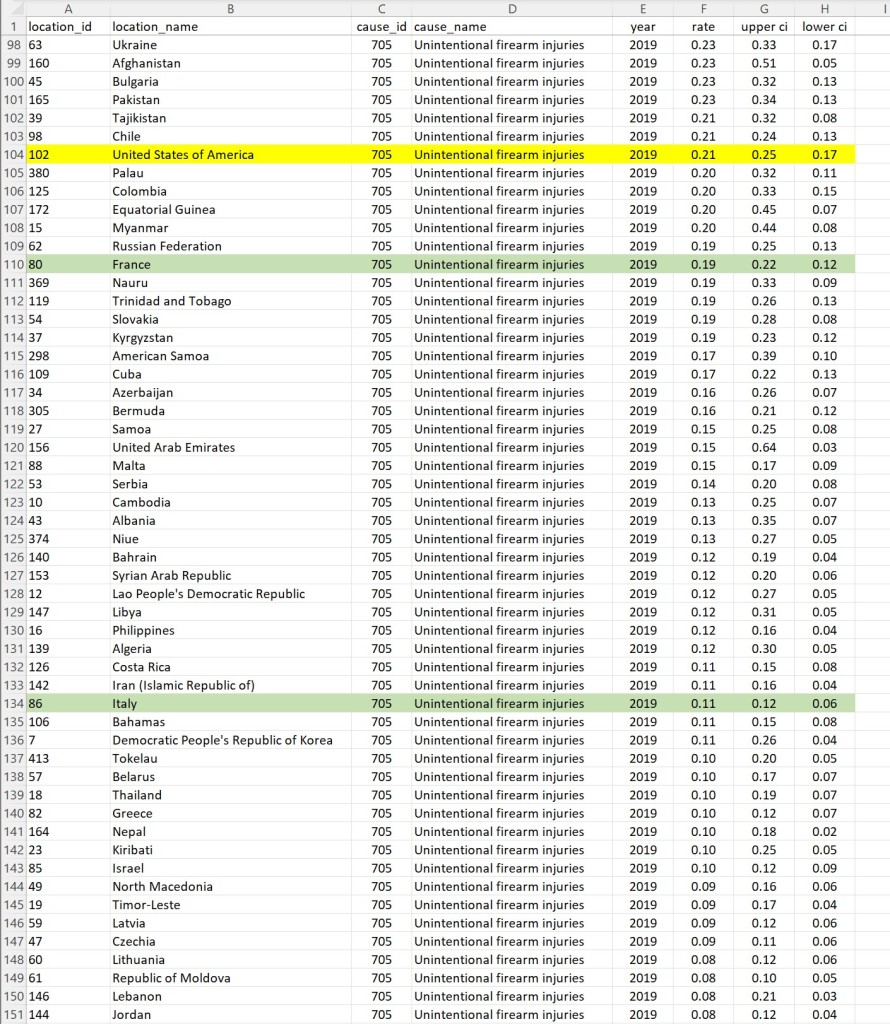Thinking About Absolute vs. Relative Risk of Negative Outcomes with Firearms
Lately, I have been working on the chapter of my book on American gun culture that explores negative outcomes with firearms.
Although I differ from most scholars studying guns by beginning not with gun deviance but with the normality of guns and gun owners, I do take negative outcomes seriously.
Trying to get a better understanding of how the United States compares to other countries in the world in terms of negative outcomes with firearms, I recently stumbled upon the Institute for Health Metrics and Evaluation (IHME) and its cross-national Global Burden of Disease (GBD) database (more about IHME GBD at the end).
The scope of the IHME GBD data is impressive:
The Global Burden of Disease is collected and analyzed by a consortium of more than 9,000 researchers in 162 countries and territories. The data capture premature death and disability from 370 diseases and injuries in 204 countries and territories, by age and sex, from 1990 to the present.
Even better, the database is publicly accessible (though permission must be requested to download) through the IHME website: https://vizhub.healthdata.org/gbd-results/.
I will be looking at the data to better understand how the United States compares to other nations in terms of homicide, suicide, and accidental death rates. Today I begin with the most straightforward of the three: accidental death by firearm.
This is interesting not only in itself, but also because it highlights something important about understanding risk when it comes to firearms. I am not among those who deny that firearms introduce risk into the lives of their owners. As I have argued on this blog and on my “Light Over Heat” YouTube channel, guns are tools that are by design dangerous, so gun owners assume a certain amount of risk for themselves and their loved ones when they bring firearms into their homes and lives. The key is to be thoughtful in understanding and mitigating risk.
When assessing how much risk firearms pose to members of a household, public health scholars typically examine the relative risk: compared to households with no firearms, how much additional risk do firearms-owning homes have? Examples abound but include the landmark studies of “gun ownership as a risk factor” by Arthur Kellermann and associates.
Now, I have critically engaged these studies, noting the limits of case-control designs, for example, but also appreciating more recent cohort studies that have been published.
Today, I want to highlight the importance of looking not just at relative risk but also at absolute risk.
For example, a recent study found that use of hormonal contraception (vs. non-use) raises the relative risk of developing breast cancer by 30%. But because the average woman has a 1-in-8 chance of developing breast cancer, the absolute risk of developing breast cancer in connection with hormonal contraception is only 0.2% more than what would be expected overall. And hormonal contraception has other benefits that offset that absolute and relative risk.
So, for starters, what does the IHME GBD data tell us about the relative and absolute risk of accidental death by firearm in the United States compared to other countries? I sorted the 204 countries for which the IHME has data from highest to lowest rate. The range is from 5.22 per 100,000 (Haiti) to 0.01 per 100,000 (Oman).
The United States falls in the middle of the pack, #103 out of 204 at 0.21 accidental gun deaths per 100,000 population. The risk is not zero, of course, but I judge the absolute risk to be low, especially considering how many guns (hundreds of millions) and gun-owning households (tens of millions) there are in the U.S. There are many more things that are likely to kill me than someone unintentionally shooting me or me unintentionally shooting myself.
But this data could be used to tell a very different story. Imagine a headline that reads: “Rate of accidental gun deaths in U.S. twice as high as Italy.” This would be true, since the rate in the U.S. is 0.21 per 100,000 and the rate in Italy is 0.11 per 100,00.
But the relative risk tells a different story than the absolute risk. The absolute risk of dying from an unintentional firearms injury in Italy is 1 in a million and in the U.S. it is 2 in a million.
Are there too many unintentional firearms deaths in the United States? Absolutely. As Kids S.A.F.E. Foundation president Derek LeBlanc says, “ZERO firearm accidents are the only acceptable goal!!®”
But these data highlight, for me at least, the importance of always examining absolute risk alongside the more commonly cited relative risk of negative outcomes with firearms.
An independent population health research organization based at the University of Washington School of Medicine, the Institute for Health Metrics and Evaluation (IHME) works with collaborators around the world to develop timely, relevant, and scientifically valid evidence that illuminates the state of health everywhere. In making our research available and approachable, we aim to inform health policy and practice in pursuit of our vision: all people living long lives in full health.
We steward one of the world’s largest scientific collaborations, the Global Burden of Diseases, Injuries, and Risk Factors Study (GBD), which involves thousands of researchers around the world. Through this project, we quantify health loss worldwide to help leaders improve health systems and address disparities. We continue to publish new GBD results regularly, adding new causes and risk factors and working to improve our methods. Additional IHME research includes forecasting Future Health Scenarios, Health Financing, and US Health Disparities, among other endeavors.



